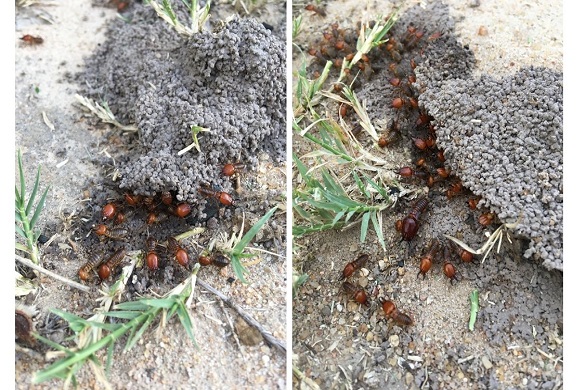
Most people think termites are a nuisance that consume wood in homes and businesses. But, these termites represent less than 4 percent of all termite species worldwide.
Termites are critical in natural ecosystems—especially in the tropics—because they help recycle dead wood from trees. Without such decayers, the world would be piled high with dead plants and animals.
These energetic wood-consuming insects could soon be moving toward the North and South poles as global temperatures warm from climate change, new research indicates.
Now an international study involving University of Liverpool researchers has found that termites are pivotal when it comes to breaking down wood, contributing to the earth’s carbon cycle. They also learned that termites are very sensitive to temperature and rainfall, so as temperatures heat up, the insect’s role in wood decay will likely expand beyond the tropics.
The research, published in the journal Science, involved more than 100 researchers who studied locations across the globe where bacteria and fungi (microbes) and termites consume dead wood. They also investigated how temperature and rainfall could impact the discovery and decay of wood by using the same experimental set up at more than 130 sites in a variety of habitats across six continents. Their results suggest that areas with high termite activity should increase as the earth becomes warmer and drier.
Professor Amy Zanne from the University of Miami led the study. She said: “With temperatures warming, the impact of termites on the planet could be huge. Termites had their biggest effects in places like tropical savannas, tropical seasonal forests and subtropical deserts. These systems are often underappreciated in terms of their contributions to the global carbon budget.”
Amy Austin, associate professor of ecology at Universidad de Buenos Aires, said: “The inclusion of arid, hot bioregions, particularly in the Southern Hemisphere, where termites are often plentiful and active, allowed for novel insight into their role in carbon turnover.”
Kate Parr, Professor of Tropical Ecology at the University of Liverpool’s School of Environmental Sciences, said: “We need to pay more attention to drier habitats such as savannas and grasslands where there is clearly potential for large change in the global carbon cycle with increasing decomposition by termites.”
“Our study also demonstrates that the old idea of microbes dominating decomposition globally needs a re-think as termites clearly come into their own across large portions of the world.”
The global project involved a diverse team of researchers worldwide, including several African students supervised by Professor Parr who provided key data in Africa.
She added “Our African PhD students really benefitted from involvement in this global project and in turn provided data from hot, dry sites that was critical to the study conclusions.”
Although microbes and termites both decompose dead wood, there are important differences between them. While microbes need water to grow and consume wood, termites can function at relatively low moisture levels. In fact, termites can search for their next meal even if it is dry out and carry what they want back to their mounds, or even move their colony into the wood they are consuming.
“Microbes are globally important when it comes to wood decay, but we have largely overlooked the role of termites in this process. This means we are not accounting for the massive effect these insects could pose for future carbon cycling and interactions with climate change,” Zanne added.
Like little cows, termites release carbon from the wood as methane and carbon dioxide, which are two of the most important greenhouse gases. Therefore, Zanne said that termites may increasingly contribute to greenhouse gas emissions with climate change.
The study `Termites sensitivity to temperature affects global wood decay rates‘ (doi: 10.1126/science.abo3856) is published in the journal Science.